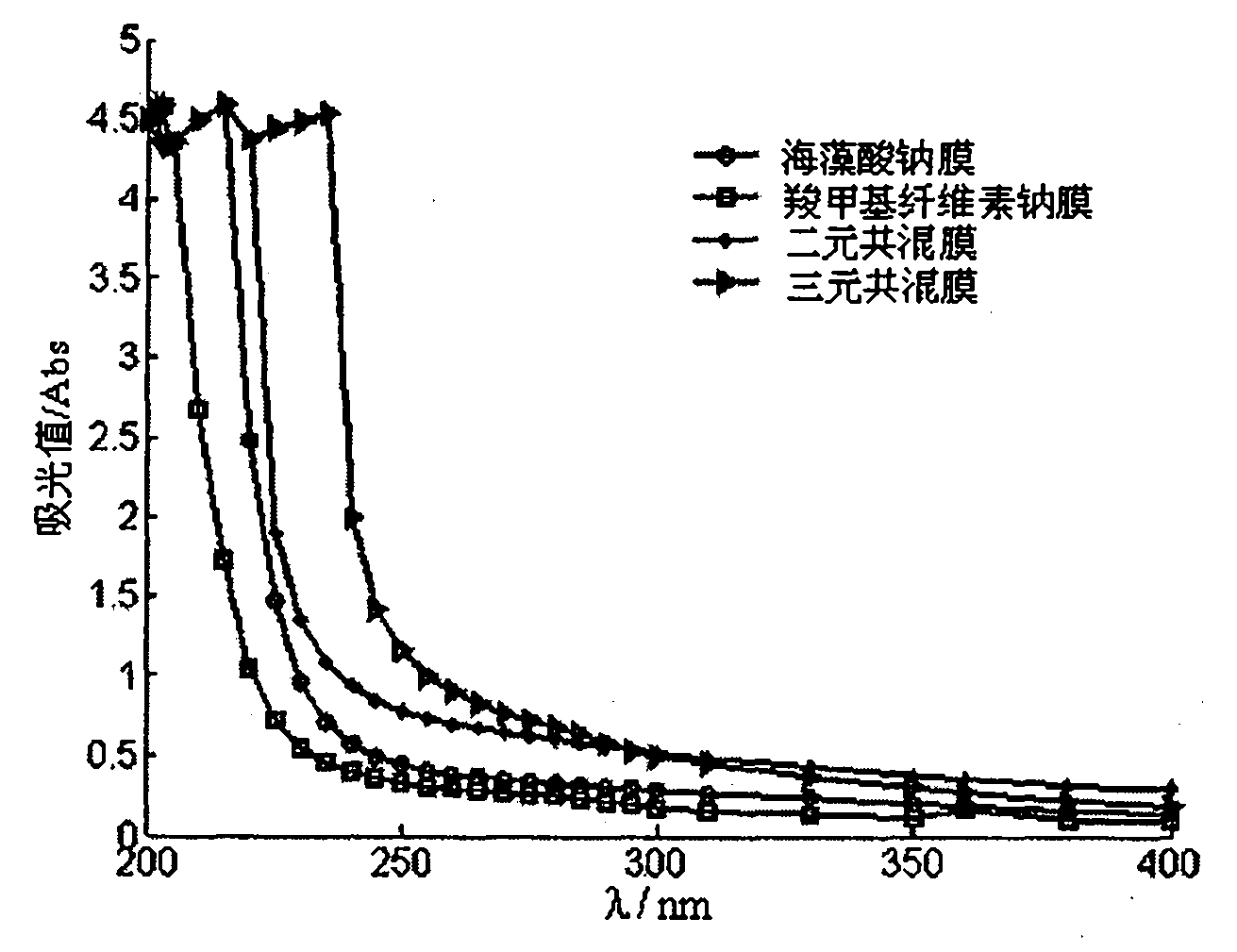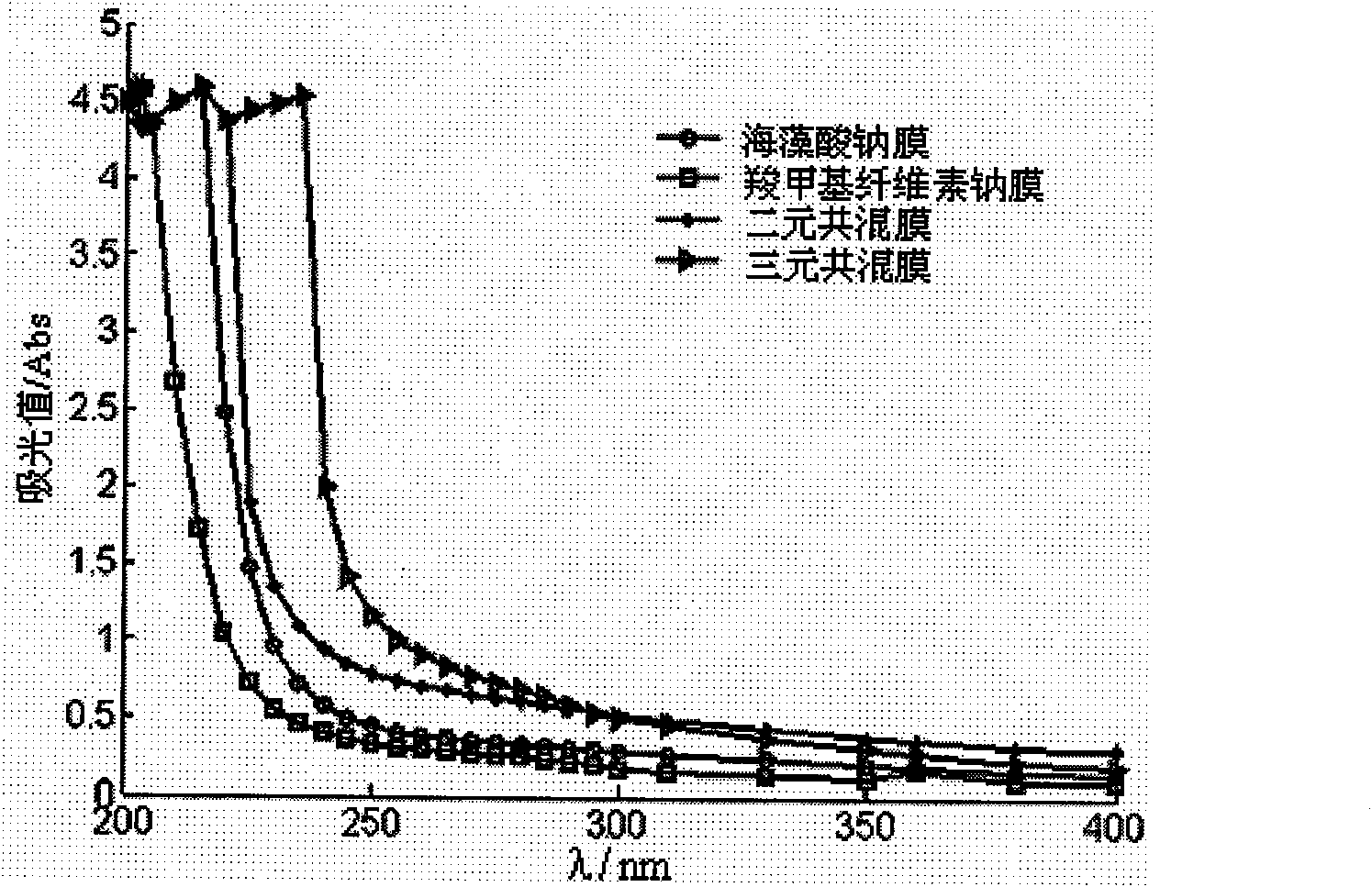Edible polysaccharide-protein composite packaging film and preparation method thereof
A composite packaging film and polysaccharide technology, applied in packaging, wrapping paper, transportation and packaging, etc., can solve the problems of insufficient mechanical strength, affecting food safety, affecting film strength and barrier properties, etc., to improve water vapor resistance and reduce Garbage pollution, the effect of increasing brilliance
- Summary
- Abstract
- Description
- Claims
- Application Information
AI Technical Summary
Problems solved by technology
Method used
Image
Examples
Embodiment 1
[0038] The preparation method of an edible polysaccharide-protein composite packaging film of the present invention adopts the following process steps:
[0039] (1) Dry 3 grams of sodium alginate and 3 grams of sodium carboxymethyl cellulose in a drying oven at a temperature of 80-120 ° C to constant weight, respectively weigh 1.875 grams of sodium alginate and 1.875 grams of carboxymethyl cellulose Plain sodium; Then take by weighing 0.75 gram of gelatin, 0.3 gram of sucrose ester, 0.1 gram of whey protein and 2.25 gram of glycerol;
[0040] (2) Transfer the weighed sodium alginate and sodium carboxymethyl cellulose to a blender for dry mixing, add 40 ml of deionized water, dissolve in a water bath at 40-70°C, and stir the mixture fully to make it uniform , the stirring speed is 190~210r / min, and the first mixed solution is obtained;
[0041] (3) Add the weighed gelatin into 10 ml of deionized water, swell for about 30 minutes at room temperature, then homogenize and emulsif...
Embodiment 2
[0049] The preparation method of an edible polysaccharide-protein composite packaging film of the present invention adopts the following process steps:
[0050] (1) Dry 5 grams of sodium alginate and 2 grams of sodium carboxymethyl cellulose in a drying oven at a temperature of 80-120 ° C to constant weight, then weigh 3 grams of sodium alginate and 1 gram of carboxymethyl cellulose Plain sodium; Take again 0.5 gram of gelatin, 0.5 gram of sucrose ester, 0.3 gram of whey protein and 3 gram of glycerol;
[0051] (2) Transfer the weighed sodium alginate and sodium carboxymethyl cellulose to a blender for dry mixing, add 40 ml of deionized water, dissolve in a water bath at 40-70°C, and stir the mixture fully to make it uniform , the stirring speed is 190~210r / min, and the first mixed solution is obtained;
[0052] (3) Add the weighed gelatin into 10 ml of deionized water, swell for about 30 minutes at room temperature, then homogenize and emulsify with a high-speed homogenizer ...
Embodiment 3
[0060] The preparation method of an edible polysaccharide-protein composite packaging film of the present invention adopts the following process steps:
[0061] (1) Dry 5 grams of sodium alginate and 2 grams of sodium carboxymethyl cellulose in a drying oven at a temperature of 80-120 ° C to constant weight, then weigh 3 grams of sodium alginate and 1 gram of carboxymethyl cellulose Vegetarian sodium; Then take by weighing 0.5 gram of gelatin, 0.1 gram of sucrose ester, 0.5 gram of whey protein;
[0062] (2) Transfer the weighed sodium alginate and sodium carboxymethyl cellulose to a blender for dry mixing, add 50 ml of deionized water, dissolve in a water bath at 40-70°C, and stir the mixture fully to make it uniform The stirring speed is 190-210r / min to prepare the first mixed solution;
[0063] (3) Add the weighed gelatin into 10 ml of deionized water, swell for about 30 minutes at room temperature, then homogenize and emulsify with a high-speed homogenizer for 3 minutes, ...
PUM
| Property | Measurement | Unit |
|---|---|---|
| Tensile strength | aaaaa | aaaaa |
Abstract
Description
Claims
Application Information
 Login to View More
Login to View More - R&D
- Intellectual Property
- Life Sciences
- Materials
- Tech Scout
- Unparalleled Data Quality
- Higher Quality Content
- 60% Fewer Hallucinations
Browse by: Latest US Patents, China's latest patents, Technical Efficacy Thesaurus, Application Domain, Technology Topic, Popular Technical Reports.
© 2025 PatSnap. All rights reserved.Legal|Privacy policy|Modern Slavery Act Transparency Statement|Sitemap|About US| Contact US: help@patsnap.com



